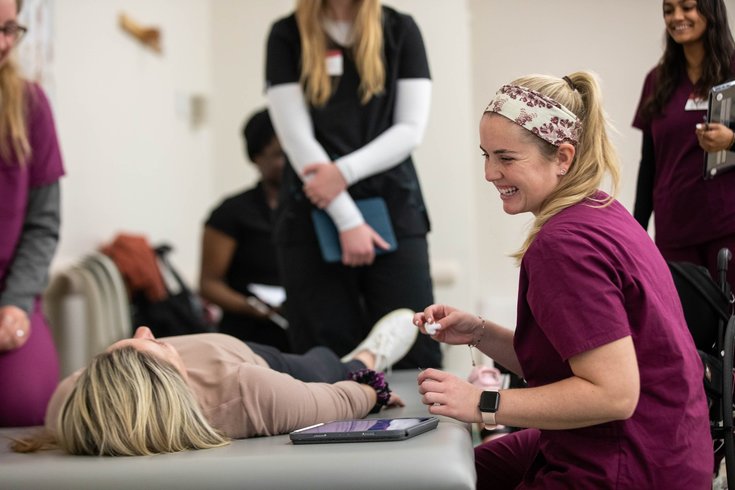
February 23, 2024
 Melissa Kelly/Saint Joseph's University
Melissa Kelly/Saint Joseph's University
A Saint Joseph's University physical therapy student helps a patient during a pro-bono clinic last year. A bill reintroduced to Congress aims to incentive people to join the field by reimbursing student loans in return for work in approved underserved and/or rural areas.
The nationwide shortage of physical therapists is causing longer wait times for appointments and also may be depriving people of a non-pharmaceutical way to manage pain – especially critical as the addiction crisis deepens across the country.
"You hear in the news that there are so many problems with drugs and addiction," said Margie Roos, acting chair and director of PT accreditation at Saint Joseph's University. "Physical therapists are a way around them. We're working really hard to get people out of pain so they don't have to take these drugs."
By using hands-on therapy and teaching patients strengthening and stretching exercises, among many other techniques, physical therapists help patients improve movement and manage pain without addictive medication, such as the opioid Oxycontin.
Fatal drug overdoses spiked to an all-time high of 112,000 last year, according to preliminary data from the U.S. Centers for Disease Control and Prevention. Philadelphia had a record 1,413 drug overdose deaths with 83% involving opioids, most commonly the synthetic opioid fentanyl, which is 50 to 100 times more potent than heroin.
A bill that died in 2021 was reintroduced to Congress last year – one that would include physical therapists in a federal program that reimburses student loans in return for work in approved underserved and/or rural areas. This aims to attract more students to the field and boost the numbers of physical therapists nationwide. It also may help patients who may not be getting optimal or any treatment – potentially reducing the need for pain medication which has contributed to the opioid crisis, Roos said.
As is the case with many types of health care professionals, physical therapists are exiting the workforce in large numbers. A 2022 study from the American Physical Therapy Association reported a 17% shortage of physical therapists at clinics across the country and a 14% shortage of physical therapy assistants.
Nick Petroski, owner of Petroski Physio in Philadelphia – a sports medicine clinic that treats high school athletes to National Football League players – said part of the reason for the shortage may be because the field has so many different specialities.
"With physical therapy, everybody thinks so many people want to work in sports, but in reality that's just a small pool," Petroski said, adding that there are a "plethora of subsets. ... Physical therapy gets pretty niche."
Doctoral programs graduate students who go on to work in hospitals or in outpatient settings with a variety of specialities ranging from oncology, where they help cancer survivors mitigate pain and restore strength, to pediatrics, where they help children cope with everything from sprained ankles to traumatic brain injuries.
The 2022 report also concluded that the coronavirus pandemic aggravated an existing shortage of physical therapists – due to issues around relocation and pay.
The average annual salary for a Philadelphia-area physical therapist runs in the range of $75,000 and $95,000, according to various pay estimation calculators on the internet.
To become a physical therapist, students have to earn a doctor of physical therapy degree after completing pre-professional undergraduate coursework. Local doctor of physical therapy programs at Drexel University, Thomas Jefferson University, Temple University and Saint Joseph's University carry a price tag between $120,000-$145,000 for classes graduating in 2024. Saint Joseph's offers an accelerated bachelor's of science to doctor of physical therapy degree program in 5 1/2 years – enabling students to graduate approximately six months earlier than they otherwise would.
The bill reintroduced to Congress last year would allow physical therapists to access the National Health Service Corps Loan Repayment Program, offering up to $50,000 repayment of individual student loans in exchange for working in underserved communities accredited by the program.
If passed, this legislation might apply to students treating patients through free clinics that Saint Joseph's and other local physical therapy schools offer for eligible Philadelphians unable to access treatment any other way because of cost, Roos said.
"Some of these copays are $40. If you're in one of these underserved communities and your copay is $40 – you're not going to get physical therapy," especially if a patient has to attend an extended period of sessions, Roos said. "Who can afford that?"